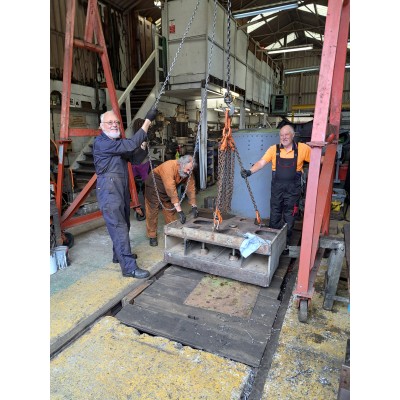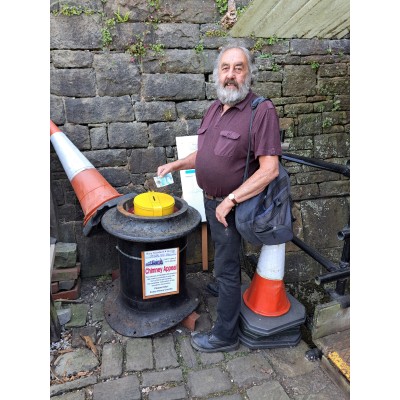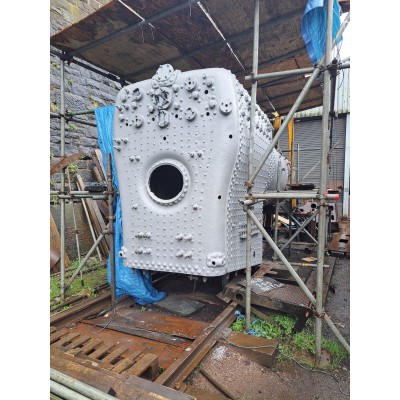Bury Standard 4 Group - Restoring 80097 and 46428
become a supporter, see how you can help learn more...
Browse now and find out more, and support us today.
Your basket is empty
Bury Standard 4 Group - Restoring 80097 and 46428
become a supporter, see how you can help learn more...
Your basket is empty

Wednesday, 9th October, 2024
BS4G - where we are up to - September 2024. By Bob Taylor Publicity Officer Bury Standard 4 Group
Apologies for the time it’s taken for this update. I have recently taken over publicity from Harry Taylor and have had some issues posting on our website. I hope to now regularly update you on what’s happening at the same time that posts appear on Facebook. Thank you for your patience.
Also thank you to Harry for his work on publicity in the past.
Standard 4 2-6-4 tank 80097
Recent times have been very difficult for us as our Loco 80097 has been laid up awaiting a solution to boiler tube failures of both small and large tubes. Initially we had replaced the small tubes and returned the loco to traffic. Shortly after the large tubes also failed. We are not absolutely sure of why we had these failures but we had no recourse.
We now have a fully re-tubed boiler which has recently passed a boiler hydraulic test up to 300 PSI. We have permission to progress to the next step, which is to carry out a coal fired test and test safety valves. We are currently awaiting safety valve overhaul and fitting and the refitting of newly machined regulator valve. We can then proceed. If successful we are anticipating a new 10 year certificate to operate. We are hoping this will see the engine in operation for the Santa Specials.
During her down time some members of our team have spent time cleaning and burnishing the motion and brightwork. She’s looking good, well done to all concerned!
Ivatt Mogul 2-6-0 46428
Significant progress has been made over the last two years. Here are the main points. It should be noted that no monies from the operation of 80097 have been used to progress this loco. We are so fortunate that we have a dedicated group of volunteers and group members who are willing to fund the purchase of components or the material to manufacture them. Our sincerest thanks go to them.
Axle boxes - All six boxes are currently at Buckley Wells shed. The financing for each axle box has, again, come from within our group at £1000 per axle box estimated cost. They stand awaiting re-metalling. This involves coating the bearing surfaces with white metal, a lead or tin based alloy which when machined gives a smooth surface suitable for bearings. The cost of white metal has recently been very high. It has now reduced a little and has been ordered. When completed the surfaces will be machined to suit the appropriate bearing surfaces. We are on the way to having a rolling chassis!
Drag box - Dave Cousins, who has been involved in the BS4G since it all started, has fully funded the drag box all the way through. This is a very heavy fabrication which must be geometrically accurate to ensure the correct alignment of the loco frames. On completion it was taken for stress relieving, as the welding process causes the component parts to act against each other in a twisting type action. This process settles that. It is currently in a local machine shop being checked for square and plumb and will be machined where necessary to ensure it is. When it is returned it will be test fitted and painted up before installation. (See below, David, Ian and Alan preparing the drag box for transportation for stress relieving). Thank you Dave.
The handrail
Has been fabricated and is now welded in place. We have a new door number and shed plate,10A, which was Wigan Springs Branch in the 1950’s where 46428 spent the majority of its working life. Whilst there it is thought likely it would have worked traffic all around the north west, including Bury. Shed codes can be changed from time to time if thought appropriate. When the smokebox is back on the saddle it will look the part.
Chimney
Our chimney is considered life expired. A search for a pattern has finally been successful. The owner has agreed to have a new one cast and it will cost £3000. The previous estimate from about 18 months ago was £2700. We have been running a chimney appeal for about twelve months now and we’ve raised over £700. We also have £1300 pledged from members. We’re not far off. Everything in the heritage sector costs are escalating. We are close. Please help if you can.
Ian Oldfield (below) is pictured making the inaugural donation to the chimney fund set up in the old chimney by our group Shop on platform 1. Thank you Ian.
Boiler
The boiler had been stood outside the workshop since removal. People often asked “what is that”? “What is happening with it”? Just over a year ago the Group board gave permission to start the process of restoration and arrange a boiler survey. We did not know the condition of the boiler and the duration of the restoration of the whole loco would depend on finance. How much will it cost to make the boiler operable? What needs doing? Who will do it? How much can we do ourselves? To know any of the answers we needed a survey.
The boiler was prepared and the survey booked. The report came back and there was a sigh of relief! It wasn’t as bad as people had feared. We then invited our insurance engineer to come and look and discuss the report. We now have a way forward. The main areas of concern are the front tube plate and at the firebox, the outer wings of the outer wrapper where there are upper and lower washout doors. All four have cracking running outwards north and south. We will have to replace a long fillet of metal first removing the affected areas. We will have four new washout doors. The outer wrapper skirt, approximately 30cm up from the bottom, will have to be replaced all around. I’m sure that in dismantling the boiler some unknown issues will be revealed including the condition of the foundation ring, it’s the very nature of such projects.
To date we have started the removal of the front tube plate. 78 rivets secure its circumference to the boiler barrel. We have completed “rivet busting” and we have removed the six longitudinal stay nuts. The six longitudinal stays run from the back head to the front tube plate. We have to remove the nuts at the tube plate to allow its removal. We are assessing the various options for a new tube plate and just how much we can do ourselves. We have an enthusiastic volunteer workforce guided by a number of skilled members who supervise and instruct the less knowledgeable members. With the right supervision and guidance we can make progress and reduce labour costs. The cost and duration of the project depends on it.
Cylinders
We are glad that our cylinders are considered machine-able and currently not requiring sleeving. We are close to awarding a contract for cylinder boring. We can then consider the work required to manufacture the pistons.
Brake hangers and beams
When obtained, the loco had only two of the six hangers and one beam of three. We obtained four replacement hangers (see below) which we have milled using the originals as a template. The brake beams we require are in the planning stage. As they are safety critical components, we must ensure the replacements are true to original design as well as materially correct. This will prove expensive as they may need to be forged. A very specialist process.
Cab
Another one of our group, Terry Holtby, has financed the provision of sheet steel, laser cut to BR drawings, which was assembled on a jig. When completed and proven correct it was hot riveted and is now painted and numbered and under a tarpaulin. When the drag box is installed it can be fitted to the frames. Thank you Terry.


